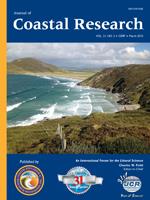Lewis, M.J.; Neill, S.P., and Elliott, A.J., 2015. Interannual variability of two offshore sand banks in a region of extreme tidal range.
Offshore sand banks play important roles for coastal flood protection and fisheries, and they are sources of marine aggregates. An 11-year record (1991–2002) of annual bathymetric surveys from two sand banks (Nash and Helwick) in the Bristol Channel (U.K.) were analysed. Both sand banks have a history of commercial dredging, and have dimensions of the order 10 km by 1 km, with a crest height rising to around 20–25 m above the surrounding sea bed. The crest at Nash Bank is exposed on the lowest spring tides, while Helwick Bank is always covered to a depth of at least 3 m. The volume of Nash Bank decreased over 10 years, and dredging was estimated to be responsible for around one third of this reduction. The volume of Helwick Bank also decreased over an 8-year period, but at a rate six times greater than the loss due to dredging. Significant interannual variability of sand bank morphology was calculated at both sites. The time during which waves alone could induce sediment transport over the sand banks was calculated between each survey date (the effective wave climate). The change in sand bank volume correlated well to the effective wave climate: a linear regression score of 77% (−0.88 Pearson correlation at the 95% significance level) and 69% (0.83 Pearson correlation at the 95% significance level) were found at Helwick and Nash, respectively. A one-dimensional morphodynamic model (UNIBEST-TC), simulated storm wave–induced changes to sand bank morphology that were consistent with those observed. Therefore, the interannual variability within storm wave events could be responsible for the observed natural variability of sand bank volume and morphology observed at both sites. We conclude that it is important to understand anthropogenic impacts upon sand banks within the context of natural variability.





